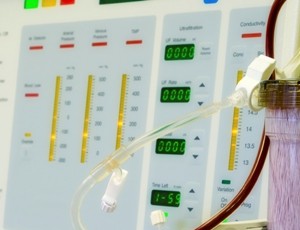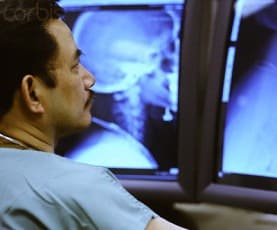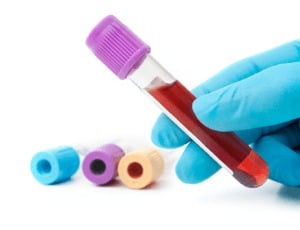Haemodialysis central venous catheter related central venous thrombosis

Central venous catheter use is common among patients undergoing haemodialysis. Catheter related vascular thrombosis is a frequent complication, which results in catheter dysfunction” Sudusinghe et al (2018). Abstract: Central venous catheter use is common among patients undergoing haemodialysis. Catheter related vascular thrombosis is a frequent complication, which results in catheter dysfunction. This may eliminate the […]
Hemodialysis central venous catheter-associated fibrin sheath in a dog

To describe an intravascular fibrin sheath associated with a hemodialysis catheter in a dog” Langston and Eatroff (2018). Abstract: OBJECTIVE: To describe an intravascular fibrin sheath associated with a hemodialysis catheter in a dog. CASE SUMMARY: A 4-year-old dog presented for hemodialysis to treat acute kidney injury. Hemodialysis catheter dysfunction during the course of treatment […]
Case study describes superior vena cava obstruction

This case represents a rare cause of acute upper gastrointestinal bleeding in an individual with a central line for dialysis leading to SVC thrombosis” Gebreselassie et al (2018). Abstract: “Downhill” esophageal varices are formed in upper two-thirds of the esophagus as a consequence of a superior vena cava obstruction. We present a case of 55-year-old […]
Impact of a vein visualisation device on pain associated with peripheral IV placement

This study was performed to define the effect of the infrared vein visualization device support on the success of PIVC in pediatric patients aged 0 to 3 years” Inal and Demir (2018). Abstract: BACKGROUND: Pediatric nurses should be able to use techniques that increase the success rate or shorten the procedural duration of peripheral intravenous […]
OPAT clinical outcomes for persons who inject drugs

Persons who inject drugs discharged home were not more likely to have complications than those discharged to a SNF/rehab. Home OPAT may be a safe discharge option in carefully selected patients” D’Couto et al (2018). Abstract: BACKGROUND: Opioid use disorder poses a significant public health risk. Persons who inject drugs (PWID) suffer from high mortality […]
Acceptability of an integrated peripheral intravenous catheter system

The study aim is to determine the efficacy, cost-utility and acceptability to patients and professionals of an integrated PIVC system compared with a non-integrated PIVC system” Castillo et al (2018). Abstract: INTRODUCTION: Peripheral intravenous catheters (PIVCs) are frequently used in hospitals. However, PIVC complications are common, with failures leading to treatment delays, additional procedures, patient […]
Ultrasound technique results in fewer posterior wall punctures during vascular access

To determine whether a long-axis, in-plane approach to ultrasound-guided vascular access produces fewer posterior wall punctures than a short-axis, out-of-plane approach when attempted by novices without prior ultrasound-guided procedural experience” Davda et al (2018). Abstract: OBJECTIVES: To determine whether a long-axis, in-plane approach to ultrasound-guided vascular access produces fewer posterior wall punctures than a short-axis, […]
Safety of fentanyl in non-intubated infants undergoing PICC placement

To evaluate the safety of fentanyl in non-intubated infants undergoing peripherally inserted central catheter (PICC) placement” Kasirer et al (2018). Abstract: OBJECTIVE: To evaluate the safety of fentanyl in non-intubated infants undergoing peripherally inserted central catheter (PICC) placement. METHODS: A retrospective chart review of PICC placements over a 3 years’ period. We compared the 12h […]
Failure to wash hands contaminates tourniquets not contamination from patient skin

Our aim was to describe the MRSA contamination rate of phlebotomy tourniquets and faucets in a tertiary care hospital and to compare the contamination of plastic tourniquets with that of fabric tourniquets” Abeywickrama et al (2018). Abstract: INTRODUCTION: Methicillin resistant Staphylococcus aureus (MRSA) is transmitted through direct contact or fomites. The most important means of […]
Directed distraction in children reduces anxiety experienced by accompanying adults

Directed distraction can be useful for managing pain in children and it reduces the anxiety experienced by accompanying adults” García-Aracil et al (2018). References: OBJECTIVES: To assess the effectiveness of a physical method of managing pain and fear in children and anxiety in the accompanying adult during venous puncture in the emergency department. MATERIAL AND […]
Reduction of procedural pain in children with the intervention of a hospital clown

Assessing the pain experience in children receiving venipuncture with the presence of a hospital clown indicates a pain relieving effect for children older than 6 years” Kristensen et al (2018). Abstract: INTRODUCTION: Hospitalized children often describe needle-related procedures as the worst pain possible and such procedures may be emotionally traumatic. The use of hospital clowns […]
Increasing parental knowledge prior to child venipuncture procedures
The results indicated that distraction type did not have a significantly different influence on child pain-related outcome variables” Newell et al (2018). Abstract: OBJECTIVES: The aim of the current research was to compare the relative efficacy of interactive and passive distraction, with or without parental psychoeducation, on child pain and distress during a venepuncture. We […]
Variability associated with potassium blood test results

Expected variability and errors exist with potassium blood tests, even when conditions are optimized” Friedman et al (2018). Abstract: OBJECTIVE: To understand the performance of a currently used clinical blood test with regard to the frequency and size of variation of the results. PATIENTS AND METHODS: From November 29, 2012, through November 29, 2013, patients […]
Methods for determining central venous catheter depth in children

The aim of this study was to assess the most reliable method for central venous catheter (CVC) tip placement in paediatric patients” Chaskar et al (2018). Abstract: OBJECTIVE: Central venous cannulation of the internal jugular vein is difficult in paediatric patients because of the small size of the vein and anatomic variations. Many studies have […]
Two small intravenous peripheral catheters for high-rate CT contrast injection

To prospectively investigate the feasibility of using 2 small intravenous catheters for high-rate computed tomography (CT) contrast injection in patients lacking superficial veins capable of accommodating ≤ 20-gauge catheters” Son et al (2018). Abstract: OBJECTIVE: To prospectively investigate the feasibility of using 2 small intravenous catheters for high-rate computed tomography (CT) contrast injection in patients […]
Malposition rate of totally implantable ports

Totally implantable venous access ports are valuable invention for oncological patients. Erroneous arterial malposition rate is estimated from 1.1% to 3.7%” Zoltowska and Kalavakunta (2018). Abstract: Totally implantable venous access ports are valuable invention for oncological patients. Erroneous arterial malposition rate is estimated from 1.1% to 3.7% (Bowen et al. Am. J. Surg., 2014, 208, […]
How to manage the extravasation of oxaliplatin

Although oxaliplatin (Oxali) plays a key role in the treatment of many types of cancer and has been reported to be an irritant, there is no specific and effective method for its extravasation and failure in Oxali extravasation management results in the need for plastic surgery” Bahadori and Demiray (2018). Abstract: Although oxaliplatin (Oxali) plays […]
What is the treatment of postoperative blood extravasation

Topical therapy with a mixture of polysulfated glycosaminoglycans provides valid protection in the therapy of blood extravasations in phlebology and general surgery” Izzo and Coscia (2018). Abstract: BACKGROUND: The onset of bruising in surgery is a frequent event that can be a source of complications and delays in the patient’s healing process (pigmentations, fibrosis, etc.). […]
Treatment for a central catheter-related right atrial thrombosis

Herein, we report the case of a patient affected by catheter-related right atrial thrombosis, who showed a quick resolution of thrombosis with a new therapeutic scheme combining loco-regional thrombolytic therapy (urokinase as a locking solution) and systemic anticoagulation therapy (vitamin K antagonists), thus avoiding catheter removal” Rossi et al (2018). Abstract: Catheter-related right atrial thrombosis […]
Central venous access port placement by translumbar approach
To evaluate the clinical results of central venous access port (CV port) placement by translumbar inferior vena cava cannulation using angio-CT unit for cancer patients with superior vena cava syndrome” Kariya et al (2018). Abstract: PURPOSE: To evaluate the clinical results of central venous access port (CV port) placement by translumbar inferior vena cava cannulation […]
Review of formulae for the correct positioning of the CVC tip in children

The aim of this review was to identify and summarize published formulae for the correct positioning of the CVC tip in children and to discuss the benefits of these formulae for the daily routine” Cleff et al (2018). Abstract: BACKGROUND: Correct positioning of a central venous catheter (CVC) tip in pediatric patients is very important. […]
Inadvertent central venous catheterization of a traumatic hemopneumothorax

This case study presents the inadvertent catheterization of a traumatic hemopneumothorax” Hobbs (2018). Abstract: This case study presents the inadvertent catheterization of a traumatic hemopneumothorax. A 22-year-old man sustained multiple stab wounds, including the left chest with a resultant hemopneumothorax. Upon arrival at a Level 1 trauma center, an ipsilateral subclavian central catheter was placed, […]
Improving pediatric home parenteral nutrition care with telemedicine
Telemedicine has been associated with improved outcomes and reduced healthcare utilization in other high-risk populations, but no studies to date have supported effectiveness of telemedicine in pediatric HPN” Raphael et al (2018). Abstract: BACKGROUND: Despite being less costly than prolonged hospitalization, home parenteral nutrition (HPN) is associated with high rates of post-discharge complications, including frequent […]
Dwell time for peripheral intravenous catheters started in the field

The purpose of this study was to compare field-start PIV catheter dwell time of 2 days or less versus field-start PIV catheter dwell time of more than 2 days for the development of indicators of infection for geriatric blunt trauma patients” Day and Conde (2018). Abstract: Replacement time for peripheral intravenous (PIV) catheters started in […]
Performing successful peripheral intravenous catheterization in difficult situations

The aim of this study is to describe the experiences of critical care nurses (CCNs) when performing successful peripheral intravenous catheterization (PIVC) on adult inpatients in difficult situations” Forsberg and Engström (2018). Abstract: The aim of this study is to describe the experiences of critical care nurses (CCNs) when performing successful peripheral intravenous catheterization (PIVC) […]
Tailored interventions in a programme to reduce CLABSI
to implement tailored interventions to reduce CLABSI rates in adult intensive care units (ICU)” Assis et al (2018). Abstract: BACKGROUND: There is a scarcity of studies exploring implementation strategies to central line-associated bloodstream infections (CLABSI) in low or middle income countries. AIM: to implement tailored interventions to reduce CLABSI rates in adult intensive care units […]
Most patients are conscious of their implantable port scar

Most patients are conscious of their port scars and if offered the choice choose placement in the arm rather than the chest” Voci et al (2018). Abstract: PURPOSE: As the number of survivors continues to increase with improvements in breast cancer treatment, greater emphasis has been placed on the aesthetic outcome following breast surgery. Effort […]
Extracorporeal photopheresis outreach service for acute graft v host disease treatment
This article describes how an ECP outpatient unit developed and implemented a fast-response ECP outreach facility for a referring hospital with the aim of improving access to treatment for this patient group” Maher et al (2018). Abstract: Acute graft v host disease (AGVHD) is the main complication and cause of non-relapse mortality following allogenic hematopoietic […]
Rapid phenotypic methods for improving the diagnosis of bloodstream infection

We aimed to discuss the wide array of phenotypic methods that have recently been developed to substantially reduce the time to result from identification to antibiotic susceptibility testing (AST)” Dubourg et al (2018). Abstract: Background: Administration of appropriate antimicrobial therapy is one of the key factors in surviving bloodstream infections. Blood culture (BC) is currently […]
ICU device-associated infections and causative HAI etiological agents

To assess the rate of device-associated infections and causative HAI etiological agents in an ICU at the National Research Center for Oncology and Transplantation (NRCOT) in Astana, Kazakhstan” Viderman et al (2018). Abstract: Background: Hospital Associated infections (HAI) are very common in Intensive Care Units (ICU) and are usually associated with use of invasive devices […]

